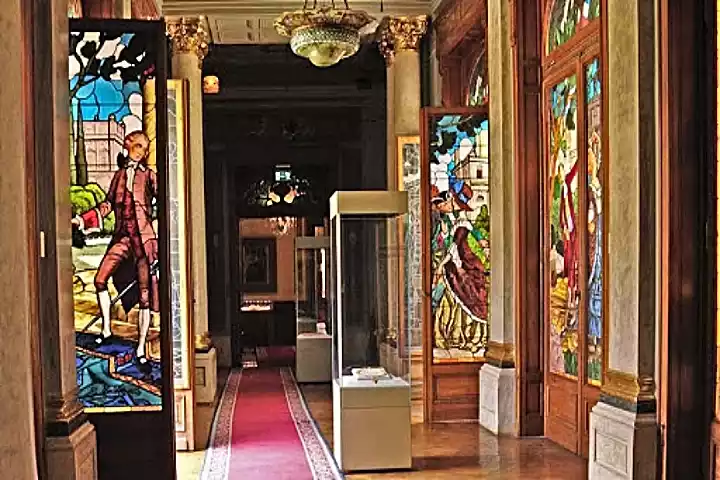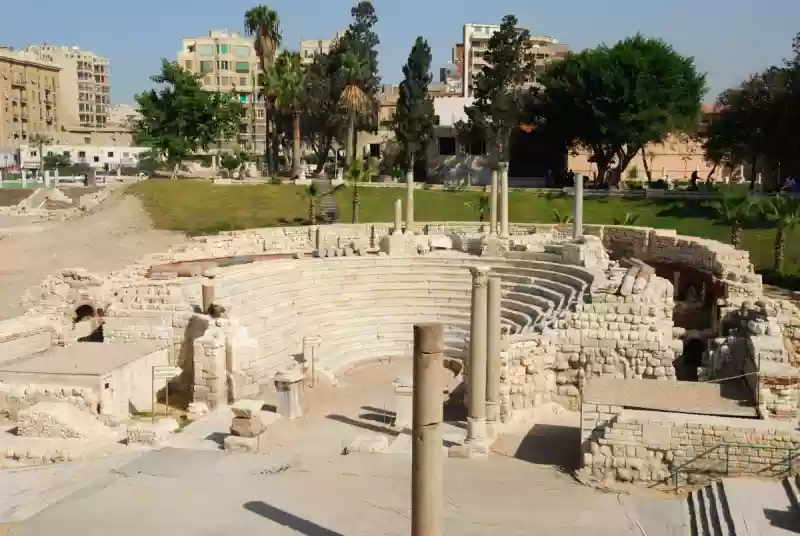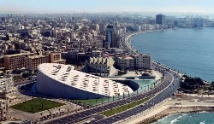The Legendary Library of Alexandria: Ancient World Wonder

What is the Library of Alexandria?
The Library of Alexandria was one of the ancient world's most famous and influential libraries. It was located in Alexandria, Egypt, and was built in the third century BC by the great ruler Ptolemy I Soter. The library was designed to house a vast collection of books and manuscripts, including works on philosophy, mathematics, science, and literature. It quickly became a center of learning and culture in the ancient world, and its influence extended far beyond Alexandria.
The Library of Alexandria was renowned for its immense collection of books and manuscripts. It was said to have contained up to 500,000 scrolls and was one of the largest collections of knowledge in the ancient world. The library was also home to several famous scholars and thinkers, including the mathematician Euclid and the astronomer Eratosthenes.
Historical Context - When the Library of Alexandria Was Built
The Library of Alexandria was built in the third century BC, during the reign of the Ptolemaic dynasty in Egypt. The library was likely commissioned by Ptolemy I Soter, the ruler of Egypt, to promote knowledge and culture in the region. The library was probably built on the site of an older temple dedicated to the Greek god Apollo, and it was designed to house a vast collection of books and manuscripts.
The Library of Alexandria quickly became an important center of learning and culture in the ancient world. It was said to contain up to 500,000 scrolls, making it one of the largest collections of knowledge in the ancient world. Scholars from all over the Mediterranean flocked to the library for learning, and it became a hub of intellectual activity.
The Library of Alexandria in Ancient Egypt
The Library of Alexandria was one of the ancient world's most important cultural and intellectual institutions. It was a significant center of learning and culture and home to several famous scholars and thinkers. The library was also a substantial source of knowledge and learning for the people of Alexandria and the surrounding regions. In addition to its vast collection of books and manuscripts, the library also served as a major center of research and learning.
The library was well-funded by the Ptolemaic rulers, and it attracted some of the best scholars and thinkers in the ancient world. It was said to have contained up to 500,000 scrolls and was one of the largest collections of knowledge in the ancient world. The library was renowned for its immense collection of books, which included works on philosophy, mathematics, science, and literature.

The burning of the library
Most historians believe Julius Caesar burned 101 ships, landing on the Mediterranean Sea shore in front of Alexandria in 48 BC. This was after little Ptolemy, Cleopatra's brother, went to fight Caesar, thinking that he was helping the queen fight against him. This great fire reached the library and caused massive damage to its buildings and books.
History also records the Roman emperor Thyosyos ordering his men to destroy the library. However, some historians claim that the library remained intact until 640 AD, when the Muslims burned it under the orders of Amr Ibn Al Aas, the Muslim leader who conquered Egypt then. Other scholars, however, believe that the library was no longer there when Amr entered Alexandria, and he had nothing to do with its damage. They also think that the library was destroyed during the reign of Julius Caesar.
The modern library

The first initiative to rebuild the Library of Alexandria dates back to 1974. However, no concrete steps took place except in the late 80s.
The first step in building the modern library was the Egyptian president's declaration that he intended to rebuild the library with the aid of UNESCO. The new library of Alexandria was launched, and the dream to reestablish the library once more was shared among all the people of Egypt and the whole world. The library was officially opened on October 17, 2002, in the location of the ancient library.
Hosny Mubarak then established the public authority of the Library of Alexandria and organized an international architectural designing competition; the prize was sixty thousand American dollars, which Snohetta, the Norwegian architectural design grand company, won.
The Library of Alexandria Today
Today, the Library of Alexandria is no longer standing; its legacy lives on. Although the original library has been lost, many ways exist to learn about its history and legacy. In recent years, archaeologists and historians have uncovered much information about the library and its contents.
The library is still a significant source of fascination for people worldwide. Many people are intrigued by the mystery of what happened to the library, and many theories about its destruction exist. There are also many relics and artifacts from the library that are still around today.

The Burning of the Library of Alexandria
The fate of the Library of Alexandria has been shrouded in mystery for centuries. Although the exact cause of its destruction is unknown, it is widely believed that a fire in the first century BC destroyed it. The fire is believed to have been started by the Roman emperor Julius Caesar, who sought to quell a revolt in Alexandria.
The fire quickly spread through the city, consuming everything in its path. The library was believed to be destroyed in the fire, and many of its priceless books and manuscripts were lost. Although the exact cause of the library's destruction is still unknown, it is widely believed that the fire destroyed it.
Theories Around the Library's Destruction
Despite the widely held belief that a fire destroyed the library, several theories exist about its destruction. Some scholars believe that an earthquake or other natural disaster destroyed the library. Others believe that the Romans deliberately destroyed the library to suppress knowledge.
The exact cause of the library's destruction remains a mystery, and it is unlikely that we will ever know what happened. However, the destruction of the library was a significant tragedy that had a lasting impact on the world of scholarship and learning.
The Aftermath of the Burning of the Library of Alexandria
The burning of the Library of Alexandria was a major tragedy and had a lasting impact on the world of scholarship and learning. The loss of the library and its immense collection of books and manuscripts was a significant blow to advancing knowledge and culture in the ancient world.
The destruction of the library also profoundly affected the people of Alexandria. For centuries, the library had been a significant source of knowledge and learning for the people of Alexandria. Its destruction was a decisive blow to the city's cultural and intellectual life.
Legacy of the Library of Alexandria
Despite the tragedy of its destruction, the Library of Alexandria's legacy lives on. The library is still a significant source of fascination for people worldwide, and its heritage has been preserved in many different ways.
The library has become the subject of many books, films, and plays, and it is a popular subject of study for scholars and historians. Its legacy is also evident in the many relics and artifacts found in the library. The library's legacy also lives on in the many modern libraries inspired by its example.
The Bibliotheca Alexandrina - Reviving the Library of Alexandria
In 2002, Alexandria opened the Bibliotheca Alexandrina, a modern library inspired by the legendary Library of Alexandria. The Bibliotheca Alexandrina is a modern library and research center home to many books, manuscripts, and other artifacts. The library is also home to several current research and educational institutions and is a significant center of learning and culture in Alexandria.
The Bibliotheca Alexandrina is a modern attempt to revive the legacy of the legendary Library of Alexandria. It is a testament to the importance of knowledge and learning in the contemporary world and a symbol of the power of knowledge to shape and change the world.
The burning of the library
Most historians believe that Julius Caesar burned 101 ships landing on the Mediterranean Sea shore in front of Alexandria in the year 48 BC; this was after little Ptolemy, the brother of Cleopatra, went to fight Caesar, thinking that he was helping the queen to fight against him. This great fire reached the library and caused massive damage to its buildings and books.
History also recorded when the Roman emperor Thyosyos ordered his man to destroy the library. However, some historians claim that the library stood still till 640 AD when the Moslems burned it under the orders of Amr Ibn Al Aas, the Muslim leader who conquered Egypt then. Some other scholars believe that when Amr entered Alexandria, the library was no longer there, and he had nothing to do with its damage and that the library was destroyed in the period of Julius Caesar.
The design of the new library

The design of the modern library of Alexandria consisted of four underground stores and six upper stores. Therefore, the unique shape of the current library of Alexandria is considered an architectural gem.
The modern library of Alexandria is located in Al Shatby in front of Al Selsela Beach.
The oval shape of the library from the outside symbolizes the continuity of life, as the sun emerges from the sea and goes from the highest to the lowest point overlooking it. The library is surrounded by a great wall made out of Aswan Granite, and it contains writing and inscriptions in 120 languages.
The library is ten stories tall and has an oval-shaped cover with a radius of 60 meters. The library is divided into reading sections, which are 14.4 × 9.6 meters in size. The library was designed to last for two centuries, but there are fears that this period might be exaggerated because of its closeness to the sea.
The new library's objective is the same as the old one: to act as a public research library and to support the people of the Arab world and the Middle East to retain their ancient position as scholars and researchers in different fields of science.
The Library of Alexandria is considered the first digital library in the whole world. It contains a place to include 8 million books, six specialized libraries, three museums, research centers, two permanent galleries, six halls to host art exhibitions, an internet archive, an audio and visual library, a unique library for blind people, a library for children, a library for teenagers, a microfilm library, the library of the rare books and a conference center.
The Library of Alexandria was one of the ancient world's most important cultural and intellectual institutions. It was a significant center of learning and culture and home to several famous scholars and thinkers. The library's legacy has been preserved in many ways, and its influence is still evident in the modern world.
Library Local Guiding
The library offers guidance services in many languages.
Group visits can be organized beforehand.
To Reserve, call this number 002-034839999 ext:1574
Library Tickets:
Tickets for Egyptians:
- Adults: 20 pounds
- Students: 8 pounds
- School students: 5-pound
- All-inclusive tickets: 8 pounds
Tickets For foreigners:
- Adults: 70 pounds
- Students: 35 pounds
- School students: 5 pounds
- All-inclusive tickets: 45 pounds
Note: Additional tickets are required to enter the other inner museums inside the library and the Skydome. Tickets are sold at the entrance of these showrooms inside the library.
Working Hours
Sunday, Monday, Wednesday, and Thursday from 11 in the morning to 7 in the afternoon.
Friday and Saturday from 3 in the afternoon until 7
The library is closed on Tuesday!




















